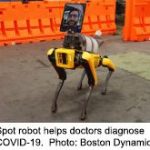
Streaks of color swirl through a pulsing, black-and-white image of a patient’s heart. They represent blood, and they’re color-coded based on speed: turquoise and green for the fastest flow, yellow and red for the slowest. This real-time video, which can be rotated and viewed from any angle, allows doctors to spot problems like a leaky heart valve or a failing surgical repair with unprecedented speed. And artificial intelligence (AI) imaging technology made it possible. “It’s quite simple, it’s like a video game,” said Dr. Albert Hsiao, an associate professor of radiology at the University of California, San Diego, who developed the technology while a medical resident at Stanford University. There’s a lot going on behind the scenes to support this simplicity. Each 10-minute scan produces 2 to 10 gigabytes of data. To handle such huge, complicated data sets, Hsiao and his colleagues at Arterys, the company he helped found in 2012 to develop the technology, decided to build the infrastructure on the internet, where it can be accessed by servers from other researchers. And now, investigators around the world are using this cloud-based infrastructure to share and test medical AI imaging models in the Arterys Marketplace. “We’ve made it almost as easy to get medical AI online as to upload a YouTube video,” said Arterys product strategy manager Christian Ulstrup. Arterys decided to open up… read on >




































